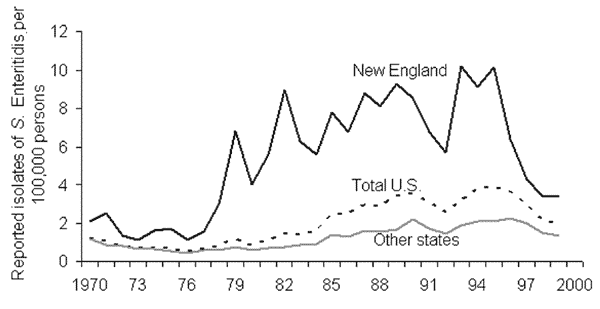Volume 10, Number 10—October 2004
Research
Egg Quality Assurance Programs and Egg-associated Salmonella Enteritidis Infections, United States
Figure 1

Figure 1. Reported isolates per 100,000 persons of Salmonella enterica serovar Enteritidis by region, United States, 1970–1999. New England: Connecticut, Maine, New Hampshire, Rhode Island, Vermont. Mid-Atlantic: New Jersey, New York, Pennsylvania. Pacific: Alaska, California, Hawaii, Oregon, Washington. Mountain: Arizona, Colorado, Montana, Nevada, New Mexico, Utah. Other states: Alabama, Arkansas, Delaware, Florida, Georgia, Illinois, Indiana, Iowa, Kansas, Kentucky, Louisiana, Maryland, Michigan, Minnesota, Mississippi, Missouri, Nebraska, North Carolina, North Dakota, Ohio, Oklahoma, South Carolina, South Dakota, Tennessee, Texas, Virginia, Washington DC, West Virginia, Wisconsin. Source: Centers for Disease Control and Prevention, National Salmonella Surveillance System (1).
References
- Centers for Disease Control and Prevention. National Salmonella Surveillance System Annual Summary, 2000. Atlanta: the Centers; 2001.
- St. Louis ME, Morse DL, Potter ME, DeMelfi TM, Guzewich JJ, Tauxe RV, The emergence of grade A eggs as a major source of Salmonella Enteritidis infections: new implication for control of salmonellosis. JAMA. 1988;259:2103–7. DOIPubMedGoogle Scholar
- Hogue A, White P, Guard-Petter J, Schlosser W, Gast R, Ebel E, Epidemiology and control of egg-associated Salmonella Enteritidis in the United States of America. Rev Sci Tech. 1997;16:542–53.PubMedGoogle Scholar
- Rhorer AR. Control of Salmonella enterica serovar Enteritidis under the U.S. National Poultry Improvement Plan. In: Saeed AM, editor. Salmonella enterica serovar Enteritidis in humans and animals: epidemiology, pathogenesis, and control. Ames (IA): Iowa State University Press; 1999. p. 307–12.
- Mason J. Salmonella Enteritidis control programs in the United States. Int J Food Microbiol. 1994;21:155–69. DOIPubMedGoogle Scholar
- U.S. Food and Drug Administration. Shell eggs. Memorandum from Division of Food Service (BF-220). Washington: the Administration; 1973.
- U.S. Food and Drug Administration. Potentially hazardous food—shell eggs. Retail food protection manual. Washington: Center for Food Safety and Applied Nutrition Retail Food Protection Branch; 1990.
- Animal and Plant Health Inspection Service. Salmonella Enteritidis control program—task force status reports. Washington: U.S. Department of Agriculture; 1993.
- Food Safety and Inspection Service. Refrigeration and labeling requirements for shell eggs. 7 CFR Part 59. Washington: U.S. Department of Agriculture; 1998.
- Animal and Plant Health Inspection Service. Veterinary and biological products. Licensees and permittees. Washington: U.S. Department of Agriculture; 2001. p. 50, 55, 83.
- Henzler DJ, Henninger M, Debok P. A five-year (1994–1999) critical analysis of the Pennsylvania egg quality assurance program (PEQAP). Proceedings of the 1999 American Veterinary Medical Association/American Association of Avian Pathologist Annual Meetings; 1999 Jul 10; New Orleans, LA. JAVMA. 1999:215. Abstract #45.
- Kradel D, Henzler D, Hanninger M. Salmonella Enteritidis (S. Enteritidis) experiences with a control program. Proceedings of the 47th North Central Avian Disease Conference and Symposium on Making and Evaluating Health Management Decisions; 1996 Sep 29–Oct 1; Columbus, OH.
- Kradel DC. Salmonella Enteritidis control: egg industry perspective. Presented at the 46th Annual New England Poultry Health Conference; 1997 Mar 26; Portsmouth, NH.
- Pennsylvania Department of Agriculture. Salmonella Enteritidis pilot project progress report. Pennsylvania Department of Agriculture, Bureau of Animal Health and Diagnostic Services; 1995.
- White PL, Schlosser W, Benson CE, Maddox C, Hogue A. Environmental survey by manure drag sampling for Salmonella Enteritidis in chicken layer houses. J Food Prot. 1997;60:1189–93.
- Henzler DJ, Kradel DC, Sischo WM. Management and environmental risk factors for Salmonella Enteritidis contamination of eggs. Am J Vet Res. 1998;59:824–9.PubMedGoogle Scholar
- Trepka MJ, Archer JR, Alterkruse SF, Proctor ME, Davis JP. An increase in sporadic and outbreak-associated Salmonella Enteritidis infections in Wisconsin: the role of eggs. J Infect Dis. 1999;180:1214–9. DOIPubMedGoogle Scholar
- Food Safety Inspection Service. Salmonella Enteritidis risk assessment: shell eggs and egg products. Washington: U.S. Department of Agriculture; 1998.
- United Egg Producers. UEP “5-STAR” total quality assurance program: a HACCP type food safety program with validation. Atlanta: United Egg Producers; 2001.
- SHAZAM Econometric Computer Program. User’s reference manual 8.0, version 8.0. Vancouver (Canada); 1997.
- Parks RW. Efficient estimation of a system of regression equations when disturbances are both serially and contemporaneously correlated. J Am Stat Assoc. 1967;62:500–9. DOIGoogle Scholar
- Kmenta J. Elements of econometrics. 2nd ed. New York: Macmillan Publishing Company; 1986.
- Green WH. Econometric analysis. Third edition. New York: McGraw Hill, Inc.; 1995.
- Gujarati ND. Basic econometrics. Third Edition. New York: McGraw Hill, Inc.; 1995.
- Abdulkadri AO, Langemeier MR. Using farm consumption data to estimate the intertemporal elasticity of substitution and relative risk aversion coefficients. Agricultural Finance Review. 2000;60:61–70. DOIGoogle Scholar
- U.S. Bureau of Census. Resident population for selected age groups (1980–1989). 2003 Mar [cited 2004 Aug 16]. Available from http://www.census.gov/population/estimates/state/estage80.txt
- U.S. Department of Agriculture/National Agricultural Statistics Service. chickens and eggs final estimates, 1970–2000. [cited 2004 Aug 16]. Available from http://usda.mannlib.cornell.edu/reports/nassr/poultry/pec-bbl/
- U.S. Department of Agriculture/Animal and Plant Inspection Service. Salmonella enterica serotype Enteritidis in table egg layers in the U.S. National Animal Health Monitoring System (NAHMS). Conyers (GA): the Department; 2000.
- Golan E, Krissof B, Kuchler F. Traceability for food marketing and food safety: what’s the next step? Agricultural Outlook. 2002;(01-2):21–5.
- Mead PS, Slutsker L, Diet V, McCaig LF, Bresee JS, Shapiro C, Food-related illness and death in the United States. Emerg Infect Dis. 1999;5:607–25. DOIPubMedGoogle Scholar